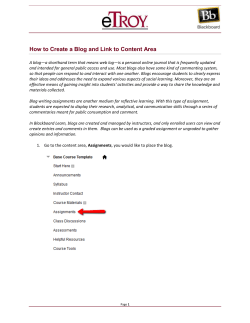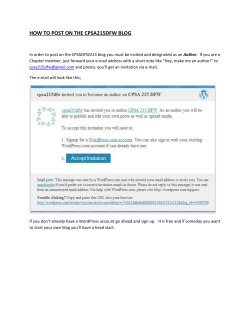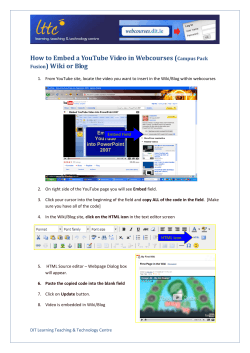
Why Use Blogs? 24/04/2012
24/04/2012 Khoo Sim Eng School of Arts and Social Sciences 20 April 2012 Why Use Blogs? • Easy to set up • Check out the Blog link in Blackboard • Free blogs at Blogger, WordPress, tumblr etc • • • • Graphic entitled “Blogs blog blogs” by Kristina B/flickr. Retrieved 29 November, 2011, from http://isnblog.ethz.ch/international-relations/partner-blogs-take-one 1 Easy to use (but there will always be Luddites) Students/Tutors can access anytime Can restrict access Can link to or insert photos, clips http://filmandpopcorn.blogspot.com/?zx=5c600720b517a688 2 BLOGS Chronologically arranged Archived by date Tagged with categories DISCUSSION BOARD Threaded by topic A Appended d d chronologically h l i ll WIKIS Website Multiple users can add, modify, delete content 3 4 Blogs are good for. . . • Disseminating information • Providing access to selected sources • News on events, developments • Background, extra info on topics, links to other sites • Establishing student involvement or deepening engagement outside course • Eg. set up a blog on a topic “To blog or not to blog” cartoon. Retrieved 29 November, 2011, from http://www.gabrielweinberg.com/blog/ 5 http://www.arsmathematica.net/ http://www.pulauhantu.org/ http://www.youngentrepreneur.com/blog/ http://goodmorningyesterday.blogspot.com/2011/10/singapore-crane-city.html 6 1 24/04/2012 Blogs are also good for. . . • Initial bonding (introductions etc) • Diagnostic Blogs are really good for. . . • Providing writing practice • Knowing others (not just your tutor) will read your post is great motivation • Not graded • W Writing iti for f different diff t purposes • Writing for different audience • Writing in response to what others write (engaging with another person’s ideas) • Reflecting on field trip, issue, project • Online journal: students can reveal a lot that they would never say in class • Eg. post a photo of an artifact at the Museum and comment on it http://blog.nus.edu.sg/eg1471kse/ http://2011sm3group4.blogspot.com/ 7 8 Designing Blog Tasks • Consider your learning outcomes • What tasks to set? • Word limit? • How many posts and comments? • How often? • Compulsory? • Do students use photos, links etc? “Tips for Blogs.” Retrieved 29 November, 2011, from http://totalwebmonitoring.com/blogtips/seo-tips-for-blogs-create-your-good-blog-article/attachment/tips-for-blogs 9 Grouping Students • Decide the grouping • Whole class shares a blog? • Sub-divide class into groups? g p • How to divide groups? • Do you need a group leader? • Note: Often easier to have individual blogs • Must make sure no one is left out 10 Monitoring/Marking Blogs • Must provide guidelines to tutors • How often do tutors monitor? • Easier to do at fixed times, not for each post • Can have cycles per sub-group • Bear in mind deadlines at UniSIM • How much tutor presence? • What should tutors write? • Touchy-feely tutors vs grumpy goats vs compulsive correctors 11 12 2 24/04/2012 Grading Blogs Sample Grading Form 1 • Learning outcomes? • What are you assessing? • Quality of writing/content? • Evidence of problem-solving? • Number of posts/comments? • Use of media? • Consistency of responses? • Do you even want to assess? 13 Sample Grading Form 2 60-74 marks 75-84 marks • 3 posts that fairly consistently have good content, organisation, and fluency • 3 mostly thoughtful comments on classmates’ work • Comments from other students consistently show some level of interest • Some evidence of effort to improve areas of weakness • Overall attractive presentation and generally easy-to-follow organisation • 4 posts that consistently have excellent content, organisation, and fluency • 4 thoughtful comments on classmates’ work • Comments from other students consistently show a high level of interest • Clear evidence of extra effort to improve areas of weakness • Overall impressive presentation and easy-tofollow organisation 14 Sample Grading Form 3 Fail High Pass • Ideas/content: not original. Most information cut and pasted. Entry makes no reference to issues raised in class/readings. l / di E Entry t shows h no personal response. • Language: poor, no evidence of proofreading. Frequent spelling, punctuation, grammar errors hinder comprehension • Participation: No evidence in span of 2 weeks • Ideas/content: conveys high interest & engagement with issues raised in class/readings. Entry shows t i personall response. extensive • Language: well-written. Proofreading is thorough with correct spelling, punctuation, grammar throughout • Participation: Active in span of 2 weeks. Responded to 5 or more postings with thoughtful reflection Content (25 marks) Language (25 marks) • Fail. Most information cut and pasted. No reference to issues raised in class/readings. 1-5 5 marks • 1 • Fail. No evidence of proofreading. Frequent spelling, punctuation, grammar errors hinder comprehension • 1-5 marks • Original and relevant. Conveys high interest & engagement with issues raised in class/readings. • 20-25 marks • Very Well-written. Proofreading is thorough with correct spelling, punctuation, grammar throughout. • 20-25 marks 15 Useful Tips • Include student name in the user handle • Teach blogging etiquette to all • Tone, choice of words • Do not criticise or be nasty/petty • DON’T SHOUT!!!! • Be careful with content • Everything is out there • Don’t over-share 17 Cartoon by Stivers. Retrieved 29 November, 2011, from http://alliemacpherson.wordpress.com/2011/01/24/why-blog/ 18 3 24/04/2012 http://www.child-psych.org/ http://www.translationblog.co.uk/ http://www.badriseshadri.in/ http://myunisim.unisim.edu.sg/webapps/portal/frameset.jsp Graphic entitled “Blogging done right.” Retrieved 29 November, 2011, from http://marketingexpert.blogspot.com/ 19 4
© Copyright 2025





















